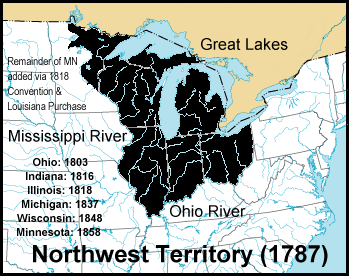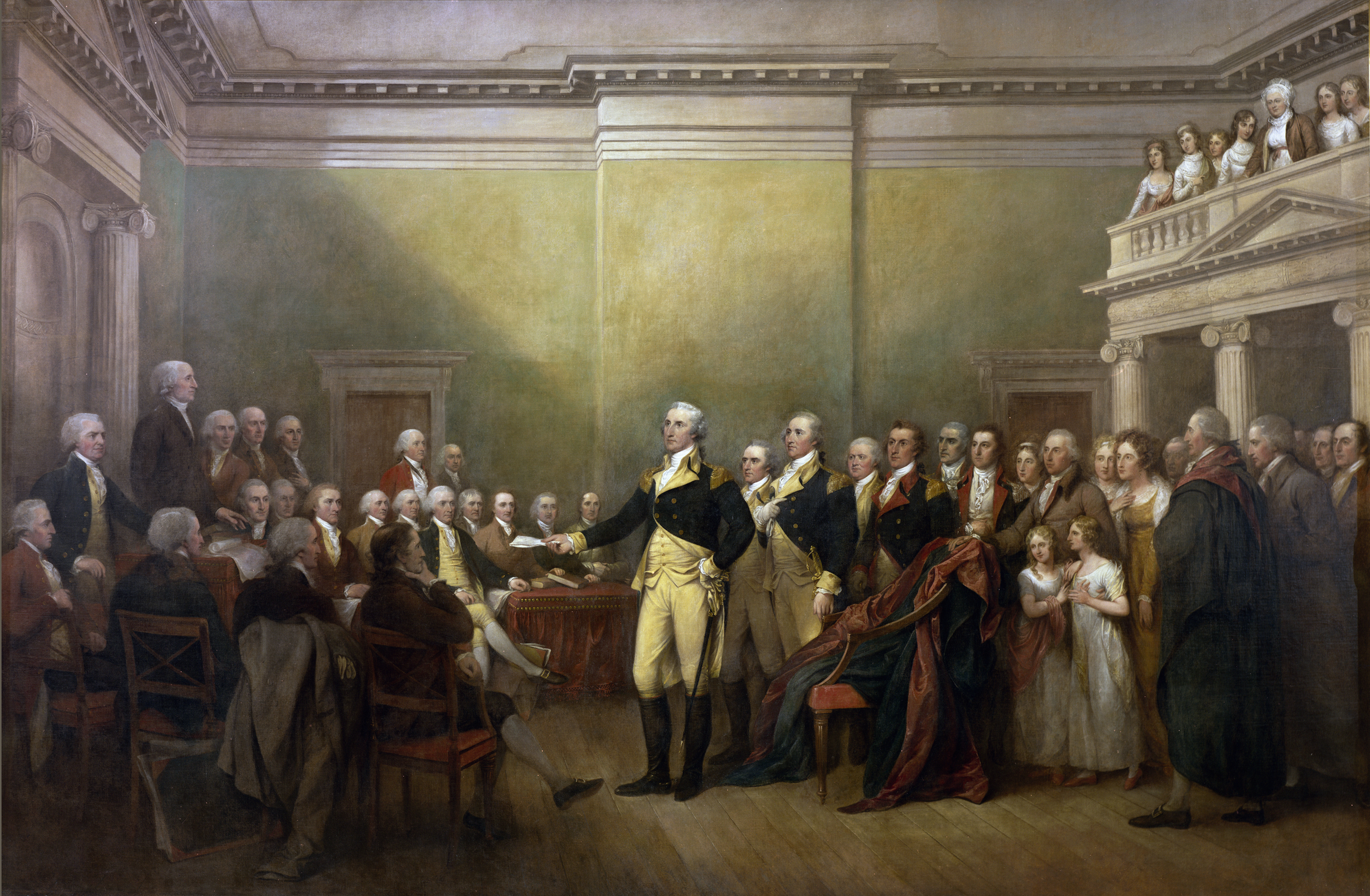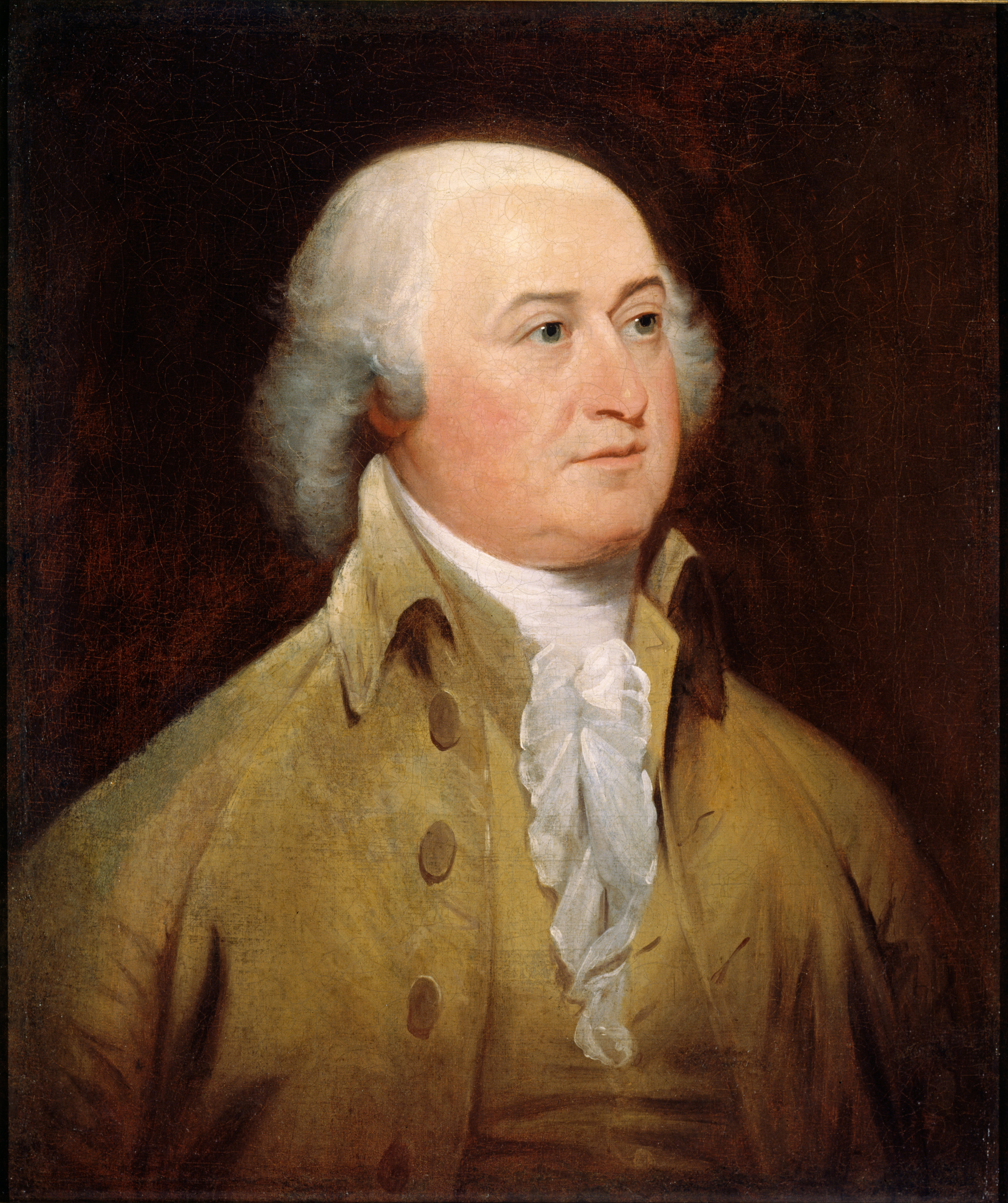|
Land Ordinance Of 1785
The Land Ordinance of 1785 was adopted by the United States Congress of the Confederation on May 20, 1785. It set up a standardized system whereby settlers could purchase title to farmland in the undeveloped west. Congress at the time did not have the power to raise revenue by direct taxation, so land sales provided an important revenue stream. The Ordinance set up a survey system that eventually covered over three-quarters of the area of the continental United States. The earlier Land Ordinance of 1784 was a resolution written by Thomas Jefferson calling for Congress to take action. The land west of the Appalachian Mountains, north of the Ohio River and east of the Mississippi River was to be divided into ten separate states. However, the 1784 resolution did not define the mechanism by which the land would become states, or how the territories would be governed or settled before they became states. The Ordinance of 1785 put the 1784 resolution in operation by providing a mechanis ... [...More Info...] [...Related Items...] OR: [Wikipedia] [Google] [Baidu] |
Northwest Ordinance
The Northwest Ordinance (formally An Ordinance for the Government of the Territory of the United States, North-West of the River Ohio and also known as the Ordinance of 1787), enacted July 13, 1787, was an organic act of the Congress of the Confederation of the United States. It created the Northwest Territory, the new nation's first organized incorporated territory, from lands beyond the Appalachian Mountains, between British North America and the Great Lakes to the north and the Ohio River to the south. The upper Mississippi River formed the territory's western boundary. Pennsylvania was the eastern boundary. In the 1783 Treaty of Paris, which formally ended the American Revolutionary War, Great Britain yielded the region to the United States. However, the Confederation Congress faced numerous problems gaining control of the land such as the unsanctioned movement of American settlers into the Ohio Valley; violent confrontations with the region's indigenous peoples; the on ... [...More Info...] [...Related Items...] OR: [Wikipedia] [Google] [Baidu] |
Congress Of The Confederation
The Congress of the Confederation, or the Confederation Congress, formally referred to as the United States in Congress Assembled, was the governing body of the United States of America during the Confederation period, March 1, 1781 – March 4, 1789. A unicameral body with legislative and executive function, it was composed of delegates appointed by the legislatures of the several states. Each state delegation had one vote. It was preceded by the Second Continental Congress (1775–1781) and was created by the Articles of Confederation and Perpetual Union in 1781. The Congress continued to refer itself as the Continental Congress throughout its eight-year history, although modern historians separate it from the two earlier congresses, which operated under slightly different rules and procedures until the later part of American Revolutionary War. The membership of the Second Continental Congress automatically carried over to the Congress of the Confederation when the latte ... [...More Info...] [...Related Items...] OR: [Wikipedia] [Google] [Baidu] |
Virginia
Virginia, officially the Commonwealth of Virginia, is a state in the Mid-Atlantic and Southeastern regions of the United States, between the Atlantic Coast and the Appalachian Mountains. The geography and climate of the Commonwealth are shaped by the Blue Ridge Mountains and the Chesapeake Bay, which provide habitat for much of its flora and fauna. The capital of the Commonwealth is Richmond; Virginia Beach is the most-populous city, and Fairfax County is the most-populous political subdivision. The Commonwealth's population was over 8.65million, with 36% of them living in the Baltimore–Washington metropolitan area. The area's history begins with several indigenous groups, including the Powhatan. In 1607, the London Company established the Colony of Virginia as the first permanent English colony in the New World. Virginia's state nickname, the Old Dominion, is a reference to this status. Slave labor and land acquired from displaced native tribes fueled the ... [...More Info...] [...Related Items...] OR: [Wikipedia] [Google] [Baidu] |
Elbridge Gerry
Elbridge Gerry (; July 17, 1744 – November 23, 1814) was an American Founding Father, merchant, politician, and diplomat who served as the fifth vice president of the United States under President James Madison from 1813 until his death in 1814. The political practice of gerrymandering is named after him. He was the second vice president to die in office. Born into a wealthy merchant family, Gerry vocally opposed British colonial policy in the 1760s and was active in the early stages of organizing the resistance in the American Revolutionary War. Elected to the Second Continental Congress, Gerry signed both the Declaration of Independence and Articles of Confederation. He was one of three men who attended the Constitutional Convention in 1787 who refused to sign the United States Constitution because it did not include a Bill of Rights at the time it was signed. After its ratification, he was elected to the inaugural United States Congress, where he was actively involved ... [...More Info...] [...Related Items...] OR: [Wikipedia] [Google] [Baidu] |
Rhode Island
Rhode Island (, like ''road'') is a U.S. state, state in the New England region of the Northeastern United States. It is the List of U.S. states by area, smallest U.S. state by area and the List of states and territories of the United States by population, seventh-least populous, with slightly fewer than 1.1 million residents 2020 United States census, as of 2020, but it is the List of U.S. states by population density, second-most densely populated after New Jersey. It takes its name from Aquidneck Island, the eponymous island, though most of its land area is on the mainland. Rhode Island borders Connecticut to the west; Massachusetts to the north and east; and the Atlantic Ocean to the south via Rhode Island Sound and Block Island Sound. It also shares a small maritime border with New York (state), New York. Providence, Rhode Island, Providence is its capital and most populous city. Native Americans lived around Narragansett Bay for thousands of years before English settler ... [...More Info...] [...Related Items...] OR: [Wikipedia] [Google] [Baidu] |
David Howell (jurist)
David Howell (January 1, 1747 – July 30, 1824) was a Delegate to the Congress of the Confederation from Rhode Island, an associate justice of the Supreme Court of Rhode Island, Attorney General of Rhode Island and a United States district judge of the United States District Court for the District of Rhode Island. Education and career Born on January 1, 1747, in Morristown, Morris County, Province of New Jersey, British America, Howell attended Eaton's Academy in Hopewell, Province of New Jersey, then graduated from the College of New Jersey (now Princeton University) in 1766 and received an Artium Magister degree in 1769 from Rhode Island College (now Brown University). He was a Professor of Natural Philosophy at Brown University from 1766 to 1824, also serving as a fellow from 1773 to 1824, as Secretary from 1780 to 1806, and as Acting President from 1791 to 1792. He was in private practice in Providence, Colony of Rhode Island and Providence Plantations, British America ... [...More Info...] [...Related Items...] OR: [Wikipedia] [Google] [Baidu] |
North Carolina
North Carolina () is a state in the Southeastern region of the United States. The state is the 28th largest and 9th-most populous of the United States. It is bordered by Virginia to the north, the Atlantic Ocean to the east, Georgia and South Carolina to the south, and Tennessee to the west. In the 2020 census, the state had a population of 10,439,388. Raleigh is the state's capital and Charlotte is its largest city. The Charlotte metropolitan area, with a population of 2,595,027 in 2020, is the most-populous metropolitan area in North Carolina, the 21st-most populous in the United States, and the largest banking center in the nation after New York City. The Raleigh-Durham-Cary combined statistical area is the second-largest metropolitan area in the state and 32nd-most populous in the United States, with a population of 2,043,867 in 2020, and is home to the largest research park in the United States, Research Triangle Park. The earliest evidence of human occupation i ... [...More Info...] [...Related Items...] OR: [Wikipedia] [Google] [Baidu] |
Hugh Williamson
Hugh Williamson (December 5, 1735 – May 22, 1819) was an American Founding Fathers of the United States, Founding Father, physician, and politician. He is best known as a signatory to the U.S. Constitution, and for representing North Carolina at the Philadelphia Convention, Constitutional Convention. Williamson was a scholar of international renown. His erudition had brought him into contact with some of the leading intellectuals of the Patriot (American Revolution), Patriot cause and, in turn, with the ferment of political ideas that eventually found expression in the Constitution. During the American Revolution, Williamson contributed his talents as physician and natural scientist to the American war effort. His experiences in that preeminent event of his generation transformed the genial scholar into an adroit politician and a determined leader in the campaign for effective national government. This leadership was evident not only at the Convention in Philadelphia but also, ... [...More Info...] [...Related Items...] OR: [Wikipedia] [Google] [Baidu] |
Confederation Congress
The Congress of the Confederation, or the Confederation Congress, formally referred to as the United States in Congress Assembled, was the governing body of the United States of America during the Confederation period, March 1, 1781 – March 4, 1789. A unicameral body with legislative and Executive (government), executive function, it was composed of delegates appointed by the legislatures of the several U.S. state, states. Each state delegation had one vote. It was preceded by the Second Continental Congress (1775–1781) and was created by the Articles of Confederation, Articles of Confederation and Perpetual Union in 1781. The Congress continued to refer itself as the Continental Congress throughout its eight-year history, although modern historians separate it from the two earlier congresses, which operated under slightly different rules and procedures until the later part of American Revolutionary War. The membership of the Second Continental Congress automatically carr ... [...More Info...] [...Related Items...] OR: [Wikipedia] [Google] [Baidu] |
1785 Land Ordinance Diagram
Events January–March * January 1 – The first issue of the ''Daily Universal Register'', later known as ''The Times'', is published in London. * January 7 – Frenchman Jean-Pierre Blanchard and American John Jeffries travel from Dover, England to Calais, France in a hydrogen gas balloon, becoming the first to cross the English Channel by air. * January 11 – Richard Henry Lee is elected as President of the U.S. Congress of the Confederation.''Harper's Encyclopaedia of United States History from 458 A. D. to 1909'', ed. by Benson John Lossing and, Woodrow Wilson (Harper & Brothers, 1910) p167 * January 20 – Battle of Rạch Gầm-Xoài Mút: Invading Siamese forces, attempting to exploit the political chaos in Vietnam, are ambushed and annihilated at the Mekong River, by the Tây Sơn. * January 27 – The University of Georgia in the United States is chartered by the Georgia General Assembly meeting in Savannah. The first students a ... [...More Info...] [...Related Items...] OR: [Wikipedia] [Google] [Baidu] |
Land Act Of 1785 Section Numbering
Land, also known as dry land, ground, or earth, is the solid terrestrial surface of the planet Earth that is not submerged by the ocean or other bodies of water. It makes up 29% of Earth's surface and includes the continents and various islands. Earth's land surface is almost entirely covered by regolith, a layer of rock, soil, and minerals that forms the outer part of the crust. Land plays important roles in Earth's climate system and is involved in the carbon cycle, nitrogen cycle, and water cycle. One-third of land is covered in trees, 15% is used for crops, and 10% is covered in permanent snow and glaciers. Land terrain varies greatly and consists of mountains, deserts, plains, plateaus, glaciers, and other landforms. In physical geology, the land is divided into two major categories: mountain ranges and relatively flat interiors called cratons. Both are formed over millions of years through plate tectonics. A major part of Earth's water cycle, streams shape the lan ... [...More Info...] [...Related Items...] OR: [Wikipedia] [Google] [Baidu] |









